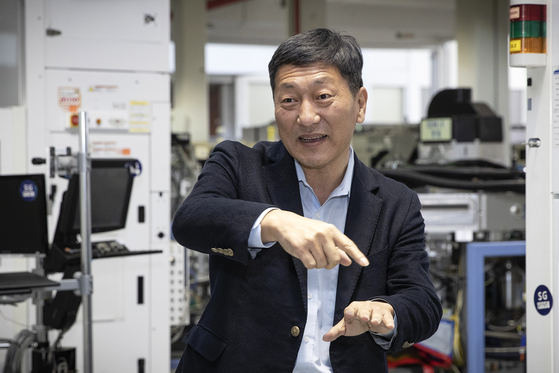Seoplus Global headquarters in Galgot-dong, Osan-si, Gyeonggi-do, visited on the 18th. In the exhibition hall of 25,000 square meters (about 7500 pyeong), about 1,500 various semiconductor equipment were exhibited.
It is the world’s largest used semiconductor equipment exhibition hall. This company is a general semiconductor company that produces power semiconductors (PMIC) for smartphones and TVs using used equipment that has been used for 10 to 15 years by large semiconductor companies such as Samsung Electronics and SK Hynix (aka’Firsteer’ companies). It is sold to’legacy’ company). It deserves to be called a’second-hand country’ in the semiconductor equipment market.
CEO Kim Jung-woong of this company started the used semiconductor equipment distribution business in 2000. Currently, it is the world’s number one in the used semiconductor equipment trading market. The company also had a lot of fun last year while riding the semiconductor’super cycle (super boom)’. Last year’s operating profit (consolidated) was 15.4 billion 181.1 billion won, a 467% increase from the previous year.
Sold 30,000 semiconductor equipment to over 40 countries.

Kim Jung-woong, CEO of Surplus Global, a used semiconductor equipment company, is interviewing with JoongAng Ilbo at an exhibition hall located in Osan, Gyeonggi-do on the morning of the 18th. Osan = Reporter Jang Jin-young
- Do high-tech industries such as semiconductors also trade used equipment?
- “The demand is steady. Semiconductor equipment prices are usually between 6 billion and 10 billion won. It is not easy to buy such equipment for research and not equipment for mass production unless it is a large company. However, since it is impossible not to do research, you will find used equipment that is 20 to 30% of the price of new equipment. Couldn’t a large company make a profit by selling equipment that couldn’t be used anyway? The used equipment market is still small. The annual global semiconductor equipment market is about 70 trillion won, while the used market is only 6 trillion won. The potential for growth is great. To date, about 30,000 units have been sold to 40 countries. There are about 4,000 trading companies.”
- “There are three big things. First, find and connect the equipment requested by the buyer. The least profitable, but the safest. The second method is to buy and store equipment that is in good condition or likely to be in high demand, and then find the owner. The margin is the best, but there is an inventory burden. It is also sold by remodeling it to the condition the buyer wants. What is important is forecasting future demand. At one time, equipment bought for 1 million dollars (about 1.1 billion won) was rotted with stock for 3 years, and then sold for 200,000 dollars (about 220 million won). Sometimes I paid 30 dollars (about 33,000 won) to repair the equipment I bought and sold it for 150,000 dollars (about 167 million won).”

Kim Jeong-woong, the world’s No. 1 supplier of used semiconductor equipment, is interviewing with JoongAng Ilbo at an exhibition hall located in Osan, Gyeonggi-do on the morning of the 18th. Osan = Reporter Jang Jin-young
- How did you get into the used semiconductor equipment trade?
- “There was no relationship with the semiconductor industry. I was familiar with the structure of buying and selling products after going to a trading company. It established a company and sold everything from chip mounters (a device that mounts ultra-precision parts on printed circuit boards of small electronic products at high speed) to pork to all over the world. Then, after seeing that the semiconductor industry was selected as a promising industry in the future, he decided to dig only one well. During the 2008 global financial crisis, the company’s debt-to-equity ratio rose to 400%, but he endured working 100 hours a week. During this period, competitors went bankrupt, and in 2011, it ranked first in the global used equipment market. It has been in the top position for 10 years.”
- Samsung Electronics and the Korean government have promoted system semiconductors. If you give advice from a position that knows the market well.
- “The share of memory semiconductors in the entire semiconductor market is around 20-30%. The remaining 70-80% are system semiconductors. The scale is different. Wouldn’t it be better to target a bigger market? For this, the ecosystem must be well established. For example, Taiwan, where TSMC, the world’s number one foundry (consignment production) company, is growing the ecosystem itself. When TSMC wins an order, its partner firms support it. It is true that Korea was inadequate because there was a perception that’semiconductor business = large enterprise industry’. In recent years, the entire industry and the government are making various attempts to revitalize the ecosystem.”

On the morning of the 18th, Kim Jung-woong, CEO of SURplus Global, a used semiconductor equipment company, poses at an exhibition hall located in Osan, Gyeonggi-do. Osan = Reporter Jang Jin-young
Semiconductor production is also like a shared office
- What is the most necessary for Korea to become a system semiconductor powerhouse?
- “Typically, there is a test bed (a system equipped with facilities to test the performance of new technologies or products). For example, if you develop a technology related to semiconductors, you must have equipment that can be tested, specialized personnel to operate the equipment, and experts to analyze the results. However, there are currently only one company that can spend a lot of money on R&D in Korea. So, we are planning to build a 9900m² (about 3,000 pyeong)’shared fab (semiconductor research and production facility)’ in the semiconductor cluster in Yongin, Gyeonggi-do, which will be completed in June. 20-30 companies move in and use semiconductor equipment or facilities together like a shared office. We are already in consultation with world-class semiconductor companies, and about five have been confirmed.”
Reporter Choi Hyun-joo [email protected]
